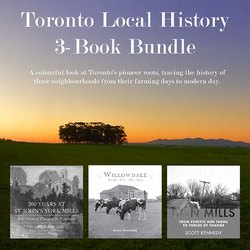Читать книгу Toronto Local History 3-Book Bundle - Scott Kennedy - Страница 6
На сайте Литреса книга снята с продажи.
Introduction
Оглавление“If you ate today, thank a farmer”
— sign on a fence post, south of Perth, Ontario, July 2011
Kids take everything for granted. I was no different. Growing up on Toronto’s rural fringe, I explored the land and buildings of abandoned farms with more a sense of adventure than a sense of loss. Abandoned barns with buggies suspended from the rafters were more playgrounds than nostalgia to me then, but what I wouldn’t give now to tuck my middle-aged brain into my boyhood skin — to go back with a camera and a notebook and at least document what I saw in a respectful fashion.
This book then, must partly be regarded as an apology to the families who worked so hard to build their beautiful farms to feed us all; an apology from a boy on a bike who was more impressed by the bulldozers than what they were bulldozing. We can never go back. Life doesn’t flow in that direction. We will never again see fields of grain at the corner of Leslie and Finch or hear the blacksmith’s hammer ringing out across Hogg’s Hollow, but we can take comfort in the stories and photos of the past, close our eyes and imagine a quieter time.
We can learn to appreciate the lives and accomplishments of these families whose names we may have only seen on street signs or historical plaques, and in so doing, offer our long overdue “thanks.”
Each chapter in this book describes either a specific farm or a specific family and follows their stories from the original Crown land grants near the dawn of the nineteenth century to the present day. It is my sincere wish that this book will give readers a new connection to present-day Willowdale and a new appreciation of those who have gone before. It’s a lot easier to be stuck in traffic if you know whose farm you are on and can take the time to consider what they had to go through to make ends meet.
The name “Willowdale” has defined different areas through different eras. The origins of the name date back to 1855 when David Gibson successfully petitioned the government of Upper Canada for a post office to serve the area around his farm at Yonge Street and Park Home Avenue. He suggested the name “Willow Dale,” which was adopted. The area to the north, between Cummer and Steeles Avenues, was referred to as Newtonbrook at this time. In 1866, another post office opened to the south of Willow Dale at the intersection of Yonge Street and Sheppard Avenue. It was called Lansing, as was the community that grew up around it. As time went by, however, postal delivery was streamlined, and by the middle of the twentieth century the slightly renamed post office of Willowdale was serving the entire area from south of Sheppard to Steeles and from Bathurst Street to Leslie Street. The names Lansing and Newtonbrook continued in use on a localized basis as the whole area gradually came to be known as Willowdale. After the amalgamation of the six separate municipal governments in Metropolitan Toronto into the new City of Toronto in 1998, the post office address for the entire city officially came under the collective name of Toronto.
For the purpose of this book, Willowdale is defined as the area south of Steeles Avenue; north of Highway 401, west of Leslie Street, and east of Bathurst Street. Street names used in these stories are present-day names to allow for an easier visualization of the location of various farms.
Map of North York with Willowdale highlighted, adapted from the Borough of North York Historical Site Map, circa 1970.
Courtesy of North York Central Library.
